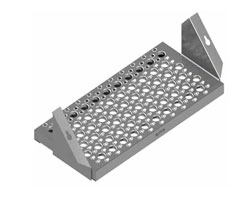Steel Stair Tread
Scaffolding Steel Stair Treads
| Use |
Steel tread are used in staircase tower where person can safely reach at required level.
|
| Material |
Structural steel.
|
| Finish | Hot Dip Galvanized. |
Buy Stainless Steel Stair Tread Brackets
AAIT uses the best premium 316L marine-grade stainless steel in making the staircase tread brackets, the most corrosion resistant material available. Hence, the brackets work good for many applications like docks, ramps, piling connections, handrails, new construction, renovation projects, and even the government facility undertakings. The confirmed quality from 316L stainless steel makes stair tread brackets resistant to rust and harsh marine environments, along with wood, making them hugely durable for projects exposed to extreme conditions.
The multi-purpose steel stair tread brackets simplify and strengthen structural connections in decks, fences, sidewalks, boardwalks, piers, boat docks, stairways, foundations, and framing. Contoured to fit U.S. dimensional lumber, staircase tread brackets are engineered to accommodate slight size variations in wood for a secure, customized fit. Options like the JH24 allows nailing flanges outward, so it can attach easily to the header beam. In contrast, the JH24IN has a hidden flange along with a sleek look, which provides more polish in tight spaces or at the beam ends.
These structural connectors offer reliable performance and are compatible with a variety of installation accessories, including 316L stainless steel bolts, screws and wedge anchors. These AAIT’s Steel Stair Tread Brackets will be ideal to use on projects that require lasting strength and superior corrosion resistance.
Benefits of staircase tread brackets
Stainless steel stair treads brackets from AAIT are made with perfect quality and for different ways of use in various constructions. Since they are constructed from superior grade 316L marine-grade stainless steel, the staircase tread brackets show incredible resistance against rusting and corrosion, so they can be used on extreme conditions like with marine-related applications and with chemical-treated woods constructions. The very good material for all deck and stairway structures, for docks, and framing will last for a very long time and will be very resilient.
Key Advantages of Steel Stair Tread :
Some benefits of stainless steel stair tread brackets include:
1. Corrosion Resistance: The 316L marine-grade stainless steel used in construction gives superior protection against rusting and corrosion in coastal or chemically harsh environments.
2. Strength: These stair tread brackets are designed with maximum strength so that you need not worry about any support your stairs, decks, and other structural applications get.
3. Versatile Use: Ideal for residential, commercial, and marine projects including docks, walkways, ramps, and framing.
4. Secured Handling: Since the steel stair tread brackets make attachments of stairs and structural elements quite secure, the chances of movement are drastically minimized, and an immovable platform is achieved.
5. Customs Options: They are available as standard as well as concealed flange designs. This difference makes it easy to carry out the installation of the stair tread brackets for many specific purposes as well as aesthetic applications.
6. Compatibility: These have been designed to fit U.S. dimensional lumber and are compatible with other 316L stainless steel installation hardware to amalgamate well into a construction project.
AAIT stainless steel stair tread brackets are strong, corrosion-resistant, and versatile, which makes them the best choice for any structural use.
FAQ
1. What is the best way to secure stair treads?
The best method for fastening stair treads is with a combination of adhesive and screws or nails, providing a reliable bond, and a firm attachment.
2. What do you attach stair treads with?
Some common fastening methods of stair treads include construction adhesives used with nails or screws to add additional stability.
3. How do you keep stair treads in place?
Keep your stair treads securely in place. Apply construction adhesive to the underside to hold the stair treads in place and nail or screw them in place so they do not shift.
4. What is the 27 rule for stairs?
The 27 rule points out the fact that the depth of the stair tread added to the height of the riser should be about 27 inches to be comfortable and safe for stairs.
5. How do you hold down stair treads?
Adhesive may be mixed with screws or nails used to drive into the stringers for holding stair treads in place.
6. How to adhere stair treads?
Construction-grade adhesive can be applied at the bottom of stair treads, and then the step pressed onto the stair stringers. This will ensure a positive installation on the stair riser and landings.
7. Should stair treads be nailed or glued?
Use both; gluing creates a strong bond with added stability through nails or screws to hold it in place.
8. What fasteners for stair treads?
Some other common fasteners used when securing stair treads are screws or finishing nails that are driven with adhesive as well.
9. How are stair treads attached to stairs?
Stair treads are attached by using adhesive at the bottom, and then driving nails or screws into the stair stringer.
| DRAWING NO | STAIR TREAD SIZE (MM) | WEIGHT IN KGS |
|---|---|---|
| ARL-ST100 | 1000 X 2000 | 8.60 |












 Download
Download